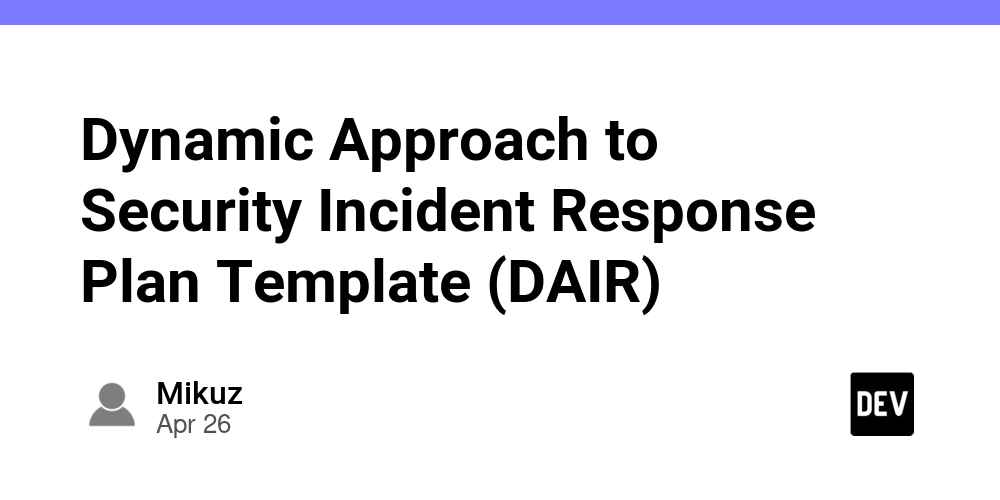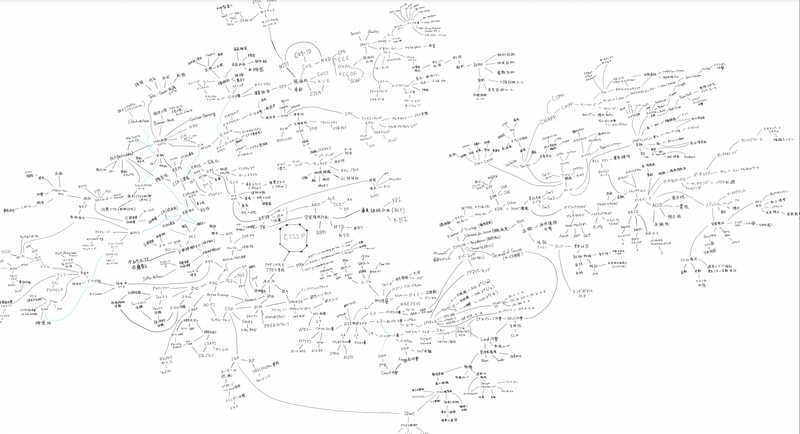Dynamic Approach to Security Incident Response Plan Template (DAIR)
Creating an effective security incident response plan template requires a flexible and dynamic approach, as security threats rarely follow a predictable pattern. Organizations must move beyond static response plans to embrace a more adaptive methodology that incorporates both analytics and automation. The Dynamic Approach to Incident Response (DAIR) framework provides a structured yet flexible way to handle security incidents, allowing teams to respond effectively to multiple concurrent threats. By breaking down incident response into distinct phases, organizations can better understand, implement, and automate their security responses while maintaining the agility needed to address emerging threats. Preparation: The Foundation of Incident Response The preparation phase forms the cornerstone of any effective security program. This critical stage focuses on building a robust foundation that minimizes potential damage from security incidents and establishes clear response protocols. Key Components of Preparation Asset Inventories: Maintain comprehensive inventories of hardware, software, and data. Baseline Protection: Understand what needs to be protected before securing it. The Center for Internet Security Controls places asset management at the top of their priority list. Policy Framework and Baseline Development Security Policies: Define the framework for security. System Baselines: Establish what "normal" looks like to detect anomalies. Training and Practice Exercises Employee Awareness Training Regular Tabletop Exercises (TTX): Simulate incidents to test response plans. Automated Prevention Measures Threat Intelligence Feeds Automation Platforms that: Monitor multiple threat sources Correlate external and internal data Update firewalls and security rules Generate alerts Maintain response playbooks Security Assessment Integration Use frameworks like NIST 800-53, CMMC, or HITRUST Automated Vulnerability Scanning for real-time insights into potential threats Detection and Verification in Modern Security Advanced Detection Technologies User and Entity Behavior Analytics (UEBA): Identifies anomalies through behavior, not just known signatures. Automated Detection Systems EDR: Endpoint Detection and Response NDR: Network Detection and Response WAFs: Web Application Firewalls SIEM: Security Information and Event Management IDS/IPS: Intrusion Detection and Prevention Systems The Verification Process Detection may be automated, but verification requires human expertise: Examine alert data Analyze logs and behavior Correlate data sources Evaluate false positives Integration of Detection Systems Unified monitoring architecture ML algorithms for: Behavior baselining Anomaly detection Alert reduction Automated triage support Supporting Verification Workflows Workflow Orchestration: Aggregate data Pre-assess incidents Assist analysts with packaged insights Incident Containment and Eradication Strategies Scoping the Security Incident Identify impacted systems and threat actor behavior Use: Network traffic analysis Host-based monitoring Containment Procedures Use SOAR tools for rapid containment: Network segmentation Patch deployment Account restrictions Firewall updates System isolation Threat Eradication Process Restore from clean backups Remove malware Eliminate compromised accounts Patch vulnerabilities Verify and restore source code Backup Management Strategy Regular, automated backups Offline storage Fast restoration Backup integrity checks Automation in Containment and Eradication SOAR playbooks for fast responses Carefully designed to avoid disrupting operations Validation and Documentation Log every action taken Support future improvements and post-incident reviews Conclusion The Dynamic Approach to Incident Response represents a major evolution in security strategy. Key Elements for Success Flexible, automated systems Regular assessments and updates Robust monitoring and detection Clear recovery protocols Incident documentation and review By combining automation, AI, and human expertise, DAIR helps organizations build resilient security programs that can adapt to changing threat landscapes while maintaining efficiency. “As threats continue to evolve, organizations must evolve too.”

Creating an effective security incident response plan template requires a flexible and dynamic approach, as security threats rarely follow a predictable pattern. Organizations must move beyond static response plans to embrace a more adaptive methodology that incorporates both analytics and automation.
The Dynamic Approach to Incident Response (DAIR) framework provides a structured yet flexible way to handle security incidents, allowing teams to respond effectively to multiple concurrent threats. By breaking down incident response into distinct phases, organizations can better understand, implement, and automate their security responses while maintaining the agility needed to address emerging threats.
Preparation: The Foundation of Incident Response
The preparation phase forms the cornerstone of any effective security program. This critical stage focuses on building a robust foundation that minimizes potential damage from security incidents and establishes clear response protocols.
Key Components of Preparation
- Asset Inventories: Maintain comprehensive inventories of hardware, software, and data.
- Baseline Protection: Understand what needs to be protected before securing it.
The Center for Internet Security Controls places asset management at the top of their priority list.
Policy Framework and Baseline Development
- Security Policies: Define the framework for security.
- System Baselines: Establish what "normal" looks like to detect anomalies.
Training and Practice Exercises
- Employee Awareness Training
- Regular Tabletop Exercises (TTX): Simulate incidents to test response plans.
Automated Prevention Measures
- Threat Intelligence Feeds
-
Automation Platforms that:
- Monitor multiple threat sources
- Correlate external and internal data
- Update firewalls and security rules
- Generate alerts
- Maintain response playbooks
Security Assessment Integration
- Use frameworks like NIST 800-53, CMMC, or HITRUST
- Automated Vulnerability Scanning for real-time insights into potential threats
Detection and Verification in Modern Security
Advanced Detection Technologies
- User and Entity Behavior Analytics (UEBA): Identifies anomalies through behavior, not just known signatures.
Automated Detection Systems
- EDR: Endpoint Detection and Response
- NDR: Network Detection and Response
- WAFs: Web Application Firewalls
- SIEM: Security Information and Event Management
- IDS/IPS: Intrusion Detection and Prevention Systems
The Verification Process
Detection may be automated, but verification requires human expertise:
- Examine alert data
- Analyze logs and behavior
- Correlate data sources
- Evaluate false positives
Integration of Detection Systems
- Unified monitoring architecture
- ML algorithms for:
- Behavior baselining
- Anomaly detection
- Alert reduction
- Automated triage support
Supporting Verification Workflows
-
Workflow Orchestration:
- Aggregate data
- Pre-assess incidents
- Assist analysts with packaged insights
Incident Containment and Eradication Strategies
Scoping the Security Incident
- Identify impacted systems and threat actor behavior
- Use:
- Network traffic analysis
- Host-based monitoring
Containment Procedures
Use SOAR tools for rapid containment:
- Network segmentation
- Patch deployment
- Account restrictions
- Firewall updates
- System isolation
Threat Eradication Process
- Restore from clean backups
- Remove malware
- Eliminate compromised accounts
- Patch vulnerabilities
- Verify and restore source code
Backup Management Strategy
- Regular, automated backups
- Offline storage
- Fast restoration
- Backup integrity checks
Automation in Containment and Eradication
- SOAR playbooks for fast responses
- Carefully designed to avoid disrupting operations
Validation and Documentation
- Log every action taken
- Support future improvements and post-incident reviews
Conclusion
The Dynamic Approach to Incident Response represents a major evolution in security strategy.
Key Elements for Success
- Flexible, automated systems
- Regular assessments and updates
- Robust monitoring and detection
- Clear recovery protocols
- Incident documentation and review
By combining automation, AI, and human expertise, DAIR helps organizations build resilient security programs that can adapt to changing threat landscapes while maintaining efficiency.
“As threats continue to evolve, organizations must evolve too.”































































































































































![[The AI Show Episode 143]: ChatGPT Revenue Surge, New AGI Timelines, Amazon’s AI Agent, Claude for Education, Model Context Protocol & LLMs Pass the Turing Test](https://www.marketingaiinstitute.com/hubfs/ep%20143%20cover.png)



























































































































![[FREE EBOOKS] AI and Business Rule Engines for Excel Power Users, Machine Learning Hero & Four More Best Selling Titles](https://www.javacodegeeks.com/wp-content/uploads/2012/12/jcg-logo.jpg)










































































































































































































































![Hostinger Horizons lets you effortlessly turn ideas into web apps without coding [10% off]](https://i0.wp.com/9to5mac.com/wp-content/uploads/sites/6/2025/04/IMG_1551.png?resize=1200%2C628&quality=82&strip=all&ssl=1)




![This new Google TV streaming dongle looks just like a Chromecast [Gallery]](https://i0.wp.com/9to5google.com/wp-content/uploads/sites/4/2025/04/thomson-cast-150-google-tv-1.jpg?resize=1200%2C628&quality=82&strip=all&ssl=1)












![Apple Drops New Immersive Adventure Episode for Vision Pro: 'Hill Climb' [Video]](https://www.iclarified.com/images/news/97133/97133/97133-640.jpg)

![Most iPhones Sold in the U.S. Will Be Made in India by 2026 [Report]](https://www.iclarified.com/images/news/97130/97130/97130-640.jpg)




































































































































